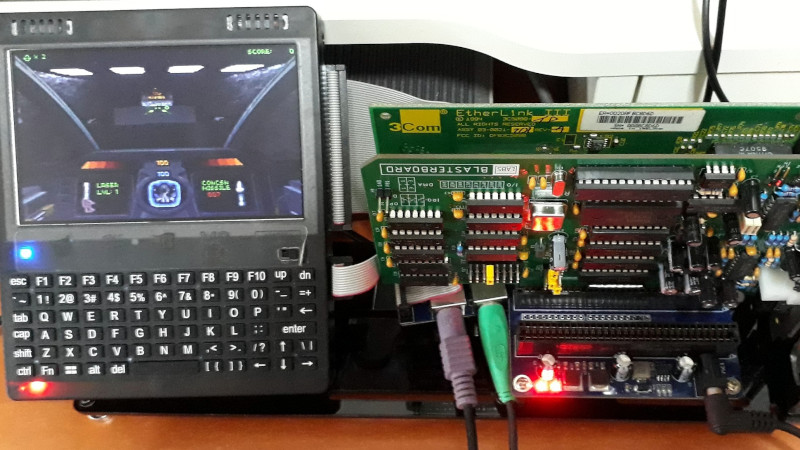A few weeks ago our community was abuzz with the news of a couple of new portable computers available through AliExpress. Their special feature was that they are brand new 2023-produced retrocomputers, one with an 8088, and the other with a 386SX. Curious to know more? [Yeo Kheng Meng] has one of the 386 machines, and he’s taken it apart for our viewing pleasure.
What he found is a well-designed machine that does exactly what it claims, and which runs Windows 95 from a CF card. It’s slow because it’s an embedded version of the 386 variant with a 16-bit bus originally brought to market as a chip that could work with 16-bit 286-era chipsets. But the designer has done a good job of melding old and new parts to extract the most from this vintage chip, and has included some decidedly modern features unheard of in the 386 era such as a CH375B USB mass storage interface.
If we had this device we’d ditch ’95 and run DOS for speed with Windows 3.1 where needed. Back in the day with eight megabytes of RAM it would have been considered a powerhouse before users had even considered its form factor, so there’s an interesting exercise for someone to get a vintage Linux build running on it.
One way to look at it is as a novelty machine with a rather high price tag, but he makes the point that considering the hardware design work that’s gone into it, the 200+ dollar price isn’t so bad. With luck we’ll get to experience one hands-on in due course, and can make up our own minds. Our original coverage is here.
















Hmmm…maybe I should buy one. My first “IBM Compatible” in 1990 was a 386SX. 20 MB HDD, Hercules-compatible graphics, monochrome monitor, all for about $1200. About the same price as I paid in 1983 for a C64, one floppy drive, mono monitor, dot-matrix printer.
Thorough tear-down and assessment. Always happy to see Decent in the wild.
Descent was pretty dang decent.
I’m normally not even into retrocomputer articles, but that caught my eye.
Yup. It supported the Forte VFX1 and many 3D shutter glasses, too. 💙
dxx compiles and runs just fine on a raspberry pi. though lately ive been playing raytraced descent 1.
Now we need to run Linux on it and get all the power back! I love minimal OSs sans having it dump me into an ML monitor.
Problem is Linux dropped 386 support a few decades ago.
If by “a few” you mean one, yes. Linux only exists a little over three.
Unsupported yes but still available for download if you dig a bit
Also did Linux ever support the 386SX at all? I know it has the same instruction set as the 386DX but that 16-bit bus presented a bunch of other interesting challenges, I think.
Linux will run on an 386SX, but it would be exceedingly slow and you’d have to make sure the kernel is built with floating point software emulation. The 16 bit bus isn’t an impediment. Remember the ISA bus is 16 bit regardless. Even in the early 90s compiling the kernel on a 486SX would take all day even with pre 1.0 kernels. But modern Linux lacks support for anything older than a 686 and there’s discussion on removing bare metal support for even that (32bit execution on AMD64 hardware would not be removed).
Your best bet for a not-Microsoft setup would be an older version of Minix or a BSD. Keep in mind that modern BSDs have removed support for 386 CPUs, so you’d need an older unsupported version. Perhaps you may have some success with FreeDOS which is still an actively maintained OS so there’s more to be done than just playing era appropriate games.
Also really amused at the slow comment cuz of CF storage… Compared to a floppy drive of the day that’s blindingly fast and probably on par or faster with a period hard drive.
Yes, we had 386 SX machines with 2/4 MB RAM running Slackware in the university computer lab back in 1996-97.
The 8088 laptop is much more interesting. He made a chipset out of 3 CPLDs.
It’s interesting, yes, I second that.
Having Norton Commander in your poqet alone does justify having one! :D
Personally, I’d replace the i8088 by a real processor, though. It’s the Shaq Fu of CPUs.
The NEC V20 usually is a compatible drop-in replacement for such systems,
unless an rarely used 808x-specfic instruction is used by BIOS code.
I believe mine came with a V20 actually. No 8087 but that’s forgivable. I’m not sure what I’d even use an 8087 for…
Woah!!!
STAR CITIZEN!!!
Maybe someone more knowledgeable than me will know: I just read the “Is Minix Dead?” article, would that be relatively easy to port to this platform (regardless of utility)?
this is not mobile solution